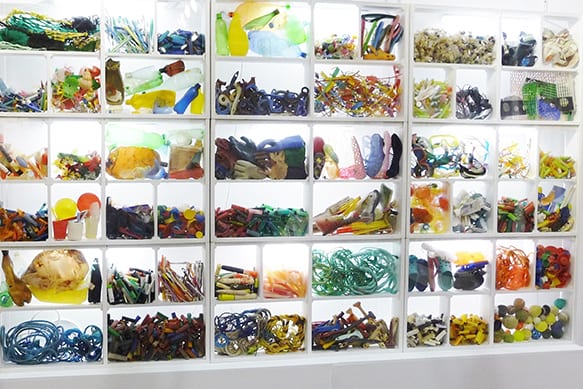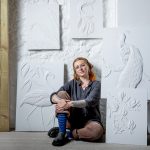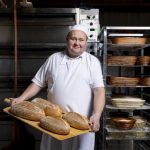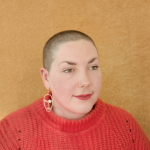“Hey, Alice, have you seen this?” Pause. “Oh my God!”
Mary Flynn is describing the reaction of the Great British Public to her Shore Archive. “It’s colourful, so it draws people in,” she says cheerfully. “And then they realise what it actually is.” What it actually is a collection of plastic objects that Mary – and her long-suffering partner Stu – picked up from the shoreline of the beaches of the Isle of Wight. All were found washed up on 11 beaches over 181 days. And Mary turned it into art.
Bottles, flip flops, toys, tags – the list goes on – having been altered by the action of the sea, are collected and displayed, their part-decomposition creating lovely drifty shapes that resemble marine life. Which is of course the point. By mimicking the natural world in which the objects were found the message is stark: man’s detritus is taking over the seas.
“I love the shore, like most people do,” says Mary, an effervescent former art teacher whose humour and seriousness are in perfect balance. We meet one heavenly spring morning at Grange Chine beach where, sure enough, among the seaweed and bits of shell on the tideline are bits of bottle and even inserts to gun cartridges:
“I became aware that once you start to look, the amount of plastic on the beach is overwhelming. So instead of collecting lovely bits of wood and shells and feathers and things, I started picking up plastic and sorting it. I kept a record of the date, photographed it and recorded where I’d collected it. So the Shore Archive is the beginning to the end of everything I collected from 2009 to 2013.”
She was further galvanised by a talk she heard by a woman who rowed oceans: “She found herself frequently rowing through plastic so she began to inform the world that the oceans are being starved of the oxygen it needs. And I thought ‘Yes! I wish I’d said that!” And so her mission began. “We have to reduce, reuse, recycle. We must buy less stuff and find creative ways of reusing what we have.”
Mary set about raising money for a big cabinet to house the installation – 45 boxes, large and small. She also photographed the collection, and during those years took it to shows and festivals from as far afield as Alexandra Palace in London to Harrogate. “Back in 2009 there was far less awareness of the implications of plastic pollution. Now we are more aware that plastics break down to form small beads. Every whale found dead on the British coast since January this year has had plastic found in its stomach.”
Along with the plastic she began picking up fabric – such as the 1970s horror, crimpoline. “Where fabric had been bashed and altered by sea and rocks they looked like continents. I incorporated all the map locations where the fabric was found, and then added photographs of objects that I put onto fabric by heat transfer.” One ‘map’ is called 23 because that was the number of languages found written on the detritus, and another was made from the dire warnings on a container: “‘Danger! Keep out of Sea!’ ‘Irritating to respiratory system. harmful to aquatic organisms, long term adverse affects to he environments” – and it was sitting there on the beach!” She called the piece ‘Poison’.
Mary is never, it seems, deterred by the sheer scale of the work she took on. “I do believe it is about all of us being conscious – but not terrified – about the consequences of throwing away things when it is still useful. Taking small measures like pressurising your MP – and making artwork! – will make a difference.”
A depiction of rock strata she made is an ingeniously subtle depiction of the mark of man on the natural world. Inspired by learning that geologists predict the earth’s strata will in future have a plastic layer she picked up bits of wood among the flotsam, which have all been marked in some way by man – painted, drilled . .
By contrast were her gabions filled with plastic objects, exhibited in 2012 at Quay Arts. Mary laughs as she describes the reaction of a friend’s companion to the show: “She said: ‘Look at this, you call this art?’ But Mary’s friend pointed out that gabions are usually made to create stability in structural landscaping. “By putting plastic into it the exact opposite is happening’, she said. “Oh!’ When she sees the penny drop, Mary’s reaction is akin to an evangelist who has saved another soul. The object is certainly not to sell the art in the Shore Archive, indeed a piece sold is described with wonder and even a sense of embarrassment. “A friend told me I should price a banner, just in case. When it sold I managed not to hug the chap and say ‘Are you sure?!”
Yet these are highly desirable and very beautiful, Mary’s technical skills with camera, sewing machine and computer telling that story that, she claims, makes people’s eyes glaze over if she talks. “That’s why I make art!” By including words – even the trig points of the locations where the objects were found, the banners say as much as needs to be said. But it isn’t the obvious tale that concerns Mary: “This will stay terrible unless just ordinary people, individuals, bright young designers, committed politicians can change it. So the notion of cleaning beaches is one little layer. The centre of it is young designers designing for re-using everything, not designing something that you use once and chuck away.”
The project had to come to an end, and she felt when she picked up a hat adorned with the skull & crossbones it was time to stop. “I didn’t need to spread the message, it is out there now,” she says. Her art is still based on re-use, and certainly on colour and form. She collaborates with the Quay Crafts group on an annual project, and for Osborne House a fabulous take on ceremonial flowers – using CDs and coloured electrical wire hung in the walled garden, and a garlanded Tiger Throne hinted at the Victorian nonchalant animal slaughter. “My work isn’t meant to be pretty but make a point.”
But while she is no longer the One Artist, collecting from 11 beaches in 118 days, she has not lost any of her determination to change the world. Bit by bit.
Mary’s favourite quote: “Never doubt that a small group of thoughtful committed citizens can change the world, indeed it’s the only thing that ever has.”
– Margaret Mead, cultural anthropologist.






